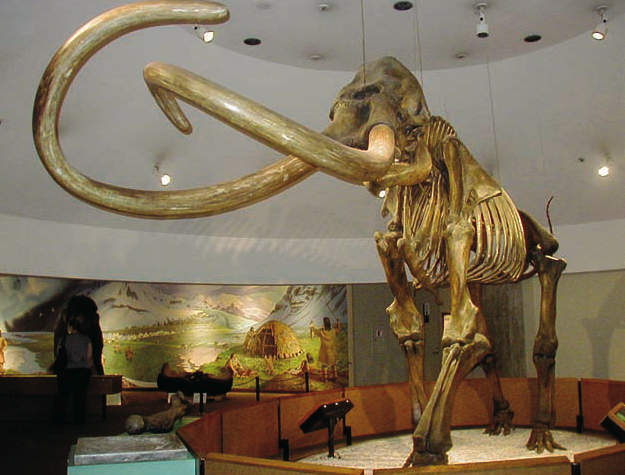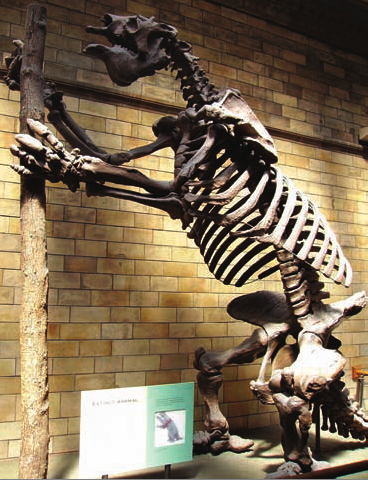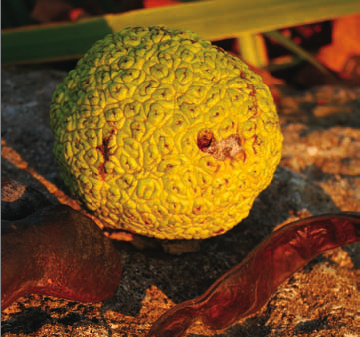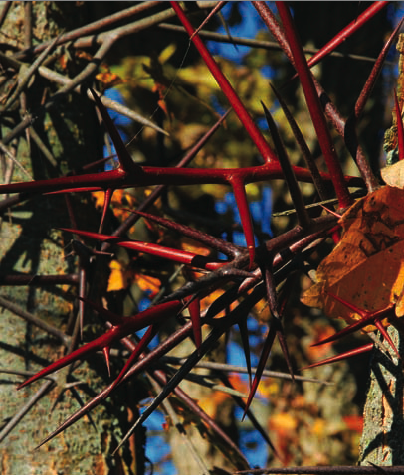Trees that once depended on animals like the wooly mammoth for survival have managed to adapt and survive in the modern world.
By Whit Bronaugh

Warning: Reading this article may cause a whiplash-inducing paradigm shift. You will no longer view wild areas the same way. Your concepts of “pristine wilderness” and “the balance of nature” will be forever compromised. You may even start to see ghosts.
Consider the fruit of the Osage-orange, named after the Osage Indians associated with its range. In the fall, Osage-orange trees hang heavy with bright green, bumpy spheres the size of softballs, full of seeds and an unpalatable milky latex. They soon fall to the ground, where they rot, unused, unless a child decides to test their ballistic properties.
Trees that make such fleshy fruits do so to entice animals to eat them, along with the seeds they contain. The seeds pass through the animal and are deposited, with natural fertilizer, away from the shade and roots of the parent tree where they are more likely to germinate. But no native animal eats Osage-orange fruits. So, what are they for? The same question could be asked of the large seed pods of the honeylocust and the Kentucky coffeetree.
To answer these questions and solve the “riddle of the rotting fruit,” we first need to go to Costa Rica. That is where tropical ecologist Dan Janzen of the University of Pennsylvania noticed that the fruits of a mid-sized tree in the pea family called Cassia grandis were generally scorned by the native animals, but gobbled up by introduced horses and cattle. Janzen, who received the Crafoord Prize (ecology’s version of the Nobel) for his work on the co-evolution of plants and animals, had the idea that the seeds of Cassia grandis, and about 40 other large-fruited Costa Rican trees, were adapted to be dispersed by large mammals that are now extinct. He teamed up with Paul Martin, a paleoecologist at the University of Arizona, to develop the concept of ecological anachronisms.

An anachronism is something that is chronologically out of place: a typewriter or floppy disc in a modern office. Leather helmets at the Super Bowl. Or, hopefully, the internal combustion engine in the near future. An ecological anachronism is an adaptation that is chronologically out of place, making its purpose more or less obsolete. A tree with big fruits to attract huge mammals as dispersers of its seeds is anachronistic in a world of relatively small mammals.
In the case of Cassia grandis, Janzen and Martin figured that the foot-long woody seed pods were eaten for their sweet pulp by giant ground sloths and elephant-like gomphotheres. These multi-ton animals had such big gullets that they didn’t need to chew a lot, so most of the seeds passed through the animals unharmed and ready to propagate more Cassia grandis trees. However, the gomphotheres and giant groundsloths disappeared about 13,000 years ago, toward the end of the last Ice Age of the Pleistocene.
Gomphotheres and ground-sloths? The Ice Age? What, you may be wondering, do they have to do with Osage-oranges, honeylocusts, and coffeetrees today?
*Are you enjoying this post? Consider supporting American Forests to help us continue our work to restore, and grow healthy and resilient forests and city canopies all over the country! And you get an award-winning magazine. Free!
In terms of evolutionary time, the difference between 13,000 years ago and now is like the difference between Friday, December 31, 1999 and Saturday, January 1, 2000. We may assign those two days to different centuries or millennia, but they are still part of the same week. Likewise, all the animals and plants of 13,000 years ago belong just as much in the present. In fact, they still live in the present, with just one major exception: most of the big and fierce animals are now gone. This happened just a couple thousand years before we invented agriculture and planted the seeds of civilization. Woolly mammoths actually survived on some Arctic islands until after the Egyptian pyramids were built!

Today, if you searched all of North America north of Mexico, you would find only 17 species of land mammals that could be called megafauna, a term for animals that exceed 100 pounds. If you exclude the rare predators and arctic animals, you are left with just 10 species: pronghorn, mountain goat, bighorn sheep, bison, elk, moose, mule deer, white-tailed deer, black bear, and grizzly bear.
If not for the end-Pleistocene extinctions just 13,000 years ago, there would still be another 40 species of North American megafauna. They would include five species of deer or moose, two llamas, a camel, three horses, four ground-sloths ranging from 400 pounds to 3 tons, a 600-pound armadillo, a 2,000-pound turtle-like glyptodont, two ox-like species, a 5-ton mastodon, a 6-ton woolly mammoth, and a 9-ton Columbian mammoth. Did I mention the 400-pound beaver? Before you jump into your time machine for a true North American safari, be advised that there were also scimitar-cats, American lions, and sabertooths, each as big as or bigger than an African lion. There were three huge bears, including the 1,800-pound giant short-faced bear, the largest mammalian predator that ever walked the Earth.
Now let’s return to the forlorn fruit of the Osage orange. Nothing today eats it. Once it drops from the tree, all of them on a given tree practically in unison, the only way it moves is to roll downhill or float in flood waters. Why would you evolve such an over-engineered, energetically expensive fruit if gravity and water are your only dispersers, and you like to grow on higher ground? You wouldn’t. Unless you expected it to be eaten by mammoths or ground-sloths.
According to my field guide, Osage-orange has a limited natural range in the Red River region of east-central Texas, southeastern Oklahoma, and adjacent Arkansas. Indians used to travel hundreds of miles for the wood, prized as the finest for making bows. Then European settlers planted it widely as living fences, taking advantage of the tree’s ability to spread via shoots from lateral roots. But Osage-orange persisted, and became widely naturalized long after the invention of barbed wire rendered them useless to farmers. The tree can now be found in 39 states and Ontario. If Osage-orange does so well elsewhere, why was it restricted to such a small area?

The answer likely lies in the disappearance of its primary disperser. Without mammoths, groundsloths, and other megafauna to transport its seeds uphill, the range of the species gradually shrank to the Red River region. In fact, fossils tell us that Osage-orange was much more widespread and diverse before the megafaunal extinctions. Back then, Osage-oranges could be found north up to Ontario, and there were seven, not just one, species in the Osage-orange genus, Maclura.
Another anachronistic tree is the Kentucky coffeetree, so named because early Kentucky settlers used its beans as a coffee substitute. Coffeetrees have tough, leathery pods with large, toxic seeds surrounded by a sweet pulp. Water cannot penetrate the thick seed coat to begin germination unless it is abraded or cut. Sounds like mammoth food to me. The natural range of coffeetrees is concentrated in the Midwest, but without its megafauna disperser, it is generally rare and mostly limited to floodplains.
Much the same can be said about the honeylocust, with its sweet seedpods up to 18 inches long. It is more common than coffeetrees, and is found in upland areas because cattle have filled in for the mastodons, camels, or some other dearly departed megamammal with a sweet tooth. The big-fruited pawpaws, persimmons, desert gourds, and wild squash may also have been dispersed more efficiently by recently extinct mammals.
Now when you see an Osage-orange, coffeetree, or honeylocust, you might sense the ghosts of megafauna munching on treats made just for them. (You may even see tropical ghosts in your local grocery store hungrily eyeing the avocados and papayas.) But you can also conjure megafaunal ghosts by considering the weapons designed by trees to discourage or slow their big mouths from eating the foliage.

Osage-orange, mesquite, and hawthorn all bear stiff thorns, spaced too widely apart to do much good against narrow deer muzzles, but they would be unavoidably painful in the wide mouths of groundsloths and mastodons. Wild honeylocusts have vicious, trident-like thorns several inches long covering the lower trunk and branches. Hollies have prickly leaves. Devil’s walkingstick is festooned with wicked prickles. In all these heavily armored trees the thorns or prickles are present well above the reach of browsing deer, where they could still frustrate a mammoth’s trunk or a giant ground-sloth’s muzzle, but no higher. Cacti, Joshua trees, and other yuccas of the Southwest are particularly well armed in case the Shasta ground-sloths return.
If some trees have evolved big fruits so that huge mammals would disperse their seeds, why, now that those dispersers are gone, do they waste their efforts on big fruits that rot on the ground with seeds that will never germinate? If some trees have been in an evolutionary arms race with megafaunal browsers, why not disarm and save energy now that their enemies have been eliminated?
It’s true that such adaptations are now anachronistic; they have lost their relevance. But the trees have been slow to catch on; a natural consequence of the pace of evolution. For a tree that lives, say, 250 years, 13,000 years represents only 52 generations. In an evolutionary sense, the trees don’t yet realize that the megafauna are gone.
This would all be just another interesting natural history story if not for the very strong likelihood – many scientists would say fact – that humans, not climate change, caused the extinction of the megafauna, mainly by hunting. Humans first came to North America from Siberia just before the megafauna became extinct. That was also at the end of the last Ice Age, but all those species had been through over 20 previous ice-age cycles and come out just fine. The same two-step sequence occurred when humans first came to the West Indies about 6,000 years ago, Australia 50,000 years ago, Madagascar 2,000 years ago, and New Zealand less than 1000 years ago. Wherever humans first colonized the world, megafauna soon disappeared, an extinction pattern that is not correlated with climate change or anything else.

Today, the evidence of human impact is all around us, but now we know that even the most pristine of wilderness areas have many missing pieces. We’ve learned to see the ghosts of the lost megafauna in the rotting fruit, poor dispersal, and useless thorns of Osage-orange, Kentucky coffeetree, honeylocust, and others. But what are we still missing?
Imagine the Columbian mammoth, larger than an African elephant and sporting curved tusks up to 16 feet long, eating 300 pounds of vegetation every day in your neck of the woods; assuming you live anywhere in the southern half of North America (if you’re in the north, just picture the smaller woolly mammoth). Now picture thousands of mammoth herds scattered across the continent. How did they affect trees and forests through their browsing, grazing, tromping, dispersing, and nutrient cycling?
Now add the mastodons, a bit more than half the size of Columbian mammoths, but still weighing 5 tons. Throw in the 3-ton giant ground-sloth and its three smaller but still big relatives. Remember the horses, camels, llamas, shrub-oxen, stag-moose, woodland muskox, and others. Don’t forget to think in terms of herds, and don’t think of them in the Ice Age. Rather, see their ghosts in the present, along your favorite forest hiking trail or peering over a fence along the interstate. How different would our forests and other habitats now be? What aspects of forest ecology do we not understand because of their absence? Is the coffeetree really a floodplain tree? Is an Osage-orange growing wild east of the Mississippi a naturalized alien, or a reintroduced native?
The first Americans could not have known they were causing extinctions, and they could not have understood the implications. But we no longer have such an excuse. As Aldo Leopold has advised, “The first rule of intelligent tinkering is to save all the pieces.” We have tinkered, lost some of the most important pieces, and tried to put many where they don’t belong. That we will continue to tinker there is no doubt. Everything will depend on how intelligently we do it. And that will depend, in part, on our ability to see the ghosts that haunt our trees.
Whit Bronaugh writes from Eugene, Oregon. Look for his work on Big Trees in the Spring issue.
This article was published in the Winter 2010 issue of American Forests magazine.